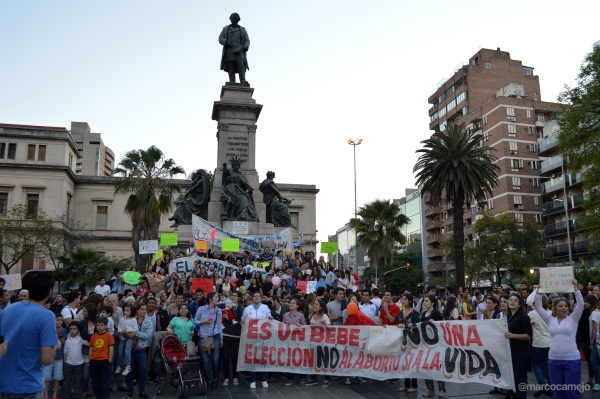By Merike Blofield and Christina Ewig*

A demonstration against abortion in Córdoba, Argentina, shortly after President Mauricio Macri’s election. / Marco Camejo / Flickr / Creative Commons
The end of Latin America’s “pink tide” suggests the region will make little progress in protecting reproductive rights in coming years and may even face some policy reversals. With five Latin American governments slated to elect new leaders in 2018, and with recent elections of right-leaning governments in Chile and Argentina, Latin America may well be concluding the left-turn that has characterized the region’s politics since the early 2000s.
- The past two decades of pink tide governments coincided with a flurry of legislative activity on abortion policy – in sharp contrast to previous decades of policy stasis, when high rates of clandestine abortions coexisted with restrictive laws. Since the turn of the millennium, abortion laws have been revised by Latin American legislatures and courts on 11 separate occasions in eight different countries. Even in countries where legal reforms did not go through, legislatures debated bills at a prevalence not seen before.
- Several left governments have carried through liberalization in response to public opinion and social mobilization. Last August, for example, the Chilean Supreme Court upheld its Congress’ liberalization of abortion law – to allow for abortion under three circumstances (threat to life; fatal fetal defect; rape) – overturning the absolute prohibition that had been in effect since the last days of the Pinochet military regime in 1989. Some left governments went even further: Uruguay legalized abortion in 2012, and Mexico City did so even earlier, in 2007.
Yet left governments have not been unequivocally liberal; some have actively upheld or enacted conservative laws, even absolute prohibitions. In 2006, the Sandinista Party in Nicaragua reversed course from allowing therapeutic abortion to supporting absolute prohibition, while Ecuadoran President Rafael Correa in 2013 rejected a provision allowing abortion in the case of rape. The FMLN in El Salvador has doggedly, even brutally, enforced a total prohibition, to the detriment of many (primarily poor) women’s lives. In a recent study (published in Social Politics), we show this split in policy roughly follows the “institutionalized” vs. “populist” typology of lefts.
- Institutionalized parties – like those in Chile and Uruguay – have channels in place for civil society organizations, including feminist ones, to have bottom-up influence. Given their respect for the rules of the game, however, the institutionalized lefts are also likely to face well-organized conservative opposition, which slow down reform, shape final legislation, or even veto it altogether. In Uruguay and Chile, feminists had a voice, but conservatives were also are able to block, slow down, and water down liberalization. This is why the Uruguayan reform took so long and why in both cases the final legislation is less liberal than the original proposals.
- By contrast, populist governments, like those of Nicaragua under Daniel Ortega and Ecuador under Rafael Correa, often see advocates for liberalization as political threats – particularly feminists who also represent more general claims for individual autonomy and pluralism. Moreover, an issue like abortion, where the practical costs of a restrictive stance are born almost exclusively by low-income women, is likely to be used by populist leaders as a pawn in a power struggle with well-organized, influential religious forces.
Although we systematically analyzed only abortion politics, we found that sex education, contraceptive access, and other reproductive health policies more broadly have followed similar dynamics in Ecuador, Nicaragua, Chile, and Uruguay. For example, the Uruguayan left government expanded sex education after assuming power in 2006, while in Ecuador, leaders appointed in health bureaucracies sought to reduce access to publically provided reproductive health services. Nicaragua, on the other hand, has the highest rate of teenage pregnancies outside sub-Saharan Africa.
As Latin America’s left shift appears to be coming to a close, reproductive health policies promise to remain contentions – and abortion continues to be a public health crisis across most of Latin America even with the limited liberalizations of the past decade. The Alan Guttmacher Institute recently estimated that 6.5 million abortions are annually performed in the region. The vast majority are still done in clandestinity, resulting in high maternal mortality and tens of thousands of annual hospitalizations, which affect low-income women the most. While it is unlikely that recent changes will be reversed in the more institutionalized settings, the rightward shift that is occurring among especially these countries does not bode well for further liberalization and resolution to the abortion crisis.
January 18, 2018
* Merike Blofield is Associate Professor of Political Science at the University of Miami. Christina Ewig is Professor of Public Affairs and Director of the Center on Women, Gender and Public Policy at the Humphrey School of Public Affairs, University of Minnesota.
